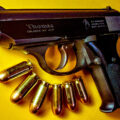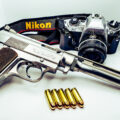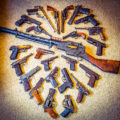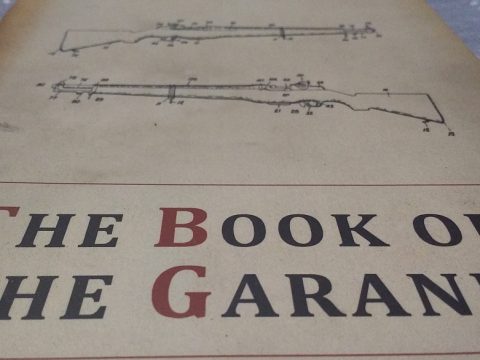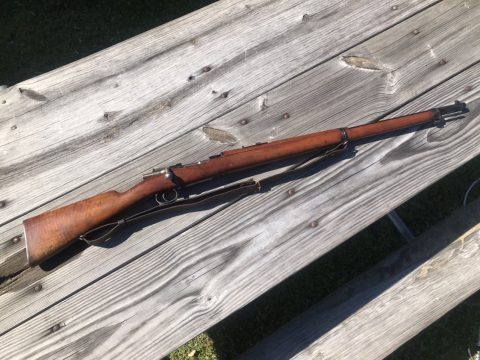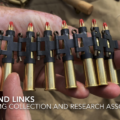For the sake of brevity, the author has split the Locked Systems portion of this article into two parts. Part 2 deals solely with the most common subcategory of locked systems – short recoil. For the other forms of locked breech handguns, please refer to the previous article “Pistol Phylogeny Part 4 – Locked (Various Designs)”.
*-*-*-*-*
Short Recoil
If long recoil includes the barrel travelling the “long” distance of just more than the entire cartridge length, the reader can likely guess that short recoil would be defined by the barrel travelling a shorter distance before decoupling from the breechface. This would be accurate. These systems usually only see the barrel remain locked to the breechface for a fraction of the distance of long recoil systems before the lock is opened and the barrel is arrested in its movement, thus allowing the opening and cycling of the action. One can see how this system would open faster and therefore be less favorable to long guns where the pressure remains higher longer. But for handguns, it proved a winning concept, leading to the most prolific and commonplace of modern pistol designs. Of these, the author has identified no less than seven categories of locking mechanism, with a few sub-categories as well.
These seven can be divided into roughly two design philosophies – guns that consist of a separate barrel and integrated slide/breechface, and guns that consist of an integrated barrel/slide and separate bolt. The author will attempt to segregate these as much as possible, but the sheer variability in this class of guns does make it a bit of a challenge.

Toggle Locked (barrel/slide & bolt)
Of the menagerie of short recoil, locked breech pistols, one of the earliest successful designs was the toggle locked system found most famously in the Luger. Toggle locked systems in general can be traced back from the Luger into both the Maxim machine gun, the entire line of early Volcanic/Henry/Winchester designs (pre-Browning of course), and even back into some small scale breech loading cap and ball offerings. Nevertheless, the Luger remains the high water mark for the concept in a semi-automatic format, with subsequent designs falling swiftly victim to the shortcomings of the system – especially expense in manufacturing.
The author’s Luger is a wonderful 1906 “American Eagle” US import gun, that he could go on about regarding its matching numbers and handling characteristics compared to the later P-08 modifications, and… Anyway. The toggle locked system of the Luger (and all such systems in general) work much like a human knee joint. When extended in a straight line, the bones lock into place such that the body can be supported with little fear of collapse. However, once bent, the knee can fold far more readily under the exertion of external force.
Toggle lock systems work similarly, with the force of recoil driving the bolt rearward and into a straight-line linkage. In the Luger, the back end of that linkage is pinned to the slide and barrel assembly, so they are drawn rearward as well. This lock is interrupted after a short distance by normal force of the frame; the iconic round toggles on the linkage strike the upward angled portion of the frame which thrusts them upward. This breaks the lock, and as the lug under the front end of the slide then strikes the back of its corresponding channel in the frame, the bolt is allowed to continue rearward the rest of the way as the linkage folds upward behind it against spring tension. Once the bolt hits its rearward limit of travel (thus ejecting the spent case) the mainspring in the grip begins to pull the linkage back down and into a straight line, which in turn pushes the bolt forward until it chambers a round fully and shoves the slide back forward and into battery.
All in all, the Luger’s toggle locked system stands out from other short recoil pistols in that the lockup does not include interlocking lugs marrying the pieces together. Instead it is locked by the physics of the recoil against specifically angled and tightly milled components. Whilst very cool, this would ultimately prove far more expensive and labor intensive to produce than some of the following designs, and thus toggle locking, at least in semi-automatic systems, has been relegated to the past.


Rotating Bolt Locked (barrel/slide & bolt)
Rotating bolts are an exceptionally common method of locking a gun, and have been used regularly in designs since bolt action rifles became a “thing”. Though less common, they still frequently show up paired to various operating systems in handguns. The aforementioned long-stroke gas operated Desert Eagle utilizes an AR style rotating bolt. The Frommer Stop pairs a rotating bolt with its long recoil action. But the author is only aware of one gun that utilizes a rotating bolt paired with a short recoil action. The AutoMag.
When at rest, the massive gun’s dual recoil springs pull the bolt forward and into lock and battery with the barrel. Upon firing, the recoil energy drives both rearward, but almost immediately the AR style bolt begins to rotate. This is facilitated by the normal force of a transverse lug that extends through the frame support that retains the bolt, and through an open cam track in the bolt itself. Shortly after fully rotating out of the locked position, the barrel/slide assembly strikes its rearward extent against the frame. This impact also engages an angled lever under the barrel that then strikes one of the locking lugs on the bolt head with some additional force to ensure it continues accelerating backwards free of the barrel. The bolt continues rearward, ejects the spent case, cocks the hammer, returns forward under spring pressure, chambers a new round, and cams back into lock and battery with the barrel/slide.
Roller Locked (barrel & slide with breechface)
Visually a roller locked gun appears to be very similar to a roller delayed gun, and indeed in construction and concept the two mechanisms are not unrelated. The difference, of course, can be identified in light of the initial definitions made above. Whereas roller delayed guns are opened purely under the recoil force within the chamber overcoming mechanical disadvantages, a roller locked gun remains locked until acted upon by the normal force of the frame and locking piece.
And thus, comes the author’s CZ-52. The bottom of the chamber end of the barrel is milled out to house two vertical rollers, and a locking piece. The locking piece consists of a rearward pointing wedge that rides between the rollers, and a forward mounted collar that slides over the barrel. When assembled, the locking piece mates snugly into a cutout in the frame that immobilizes it in relation to the barrel.
When at rest, the recoil spring drives the slide forward against the barrel, and pushes both into battery. This also wedges the rollers outward against the locking piece, and into their aligned cutouts in the slide. At this point, the rollers are not resting on the locking piece’s angled surface that they could pinch out of place like in a roller delayed system; rather they are held outward by the flat sides of the locking piece, keeping them unable to move out of lock at all. When fired the coupled barrel and slide move rearward together for a short distance before the barrel strikes its stopping surface on the frame. During this movement, the locking piece remains immobilized in the frame such that the by the time the barrel stops moving, the rollers have cleared the flats of the locking piece and are allowed to roll inward, unlocking the gun. This frees the slide to continue rearward and fully the cycle the action.
To the author’s knowledge, the CZ-52 is the only handgun to employ this system. As such, it sadly becomes very difficult to evaluate the qualities of the system, as they are overshadowed by the shortcomings of the Soviet era design choices. The safety/decocker bounces sharply into the user’s thumb, and somehow the trigger also bounces uncomfortably forward into the shooter’s finger once fired. These paired with generally rough edges and next to no polishing anywhere make the gun, whilst mechanically and historically enthralling, practically unpleasurable to shoot.


Tilting Bolt Locked (barrel & bolt)
Tilting bolts are actually not terrifically uncommon in rifles and shotguns, but in handguns they are significantly less normal. The one production handgun that the author is aware of (which inevitably means he will now find more and have to update this article yet again) is the Bergmann No. 5 or 1897. Unlike most of the long guns in this category, however, this Bergmann uses a bolt that tilts not vertically, but horizontally to lock.
At rest, a long spring on the side of the frame presses the bolt sideways into a locking recess in the left side of the barrel extension. As the barrel and bolt begin to recoil together, the bolt is cammed to the right by the frame against the spring. Ultimately the barrel extension is caught by the frame and the bolt freed to run through the rest of its cycle.
The Bergmann No. 5 unfortunately falls into the category of probably being far too rare and expensive to ever grace the author’s collection, but nevertheless, the side tilting action generates much curiosity about its effect on the recoil impulse.
Falling Barrel Locked (barrel & slide with breechface)
The locked breech systems described up to this point have all included some sort of mechanism (bolt head, toggle linkage, rollers, etc.) that have provided the locking surfaces; however, the next three designs feature the barrel itself acting as the locking mechanism.
The first design the author will here tackle, is the handful of falling barrel designs. These include guns such as the early Colt 1902 and 1903 “hammer” guns, as well as the 1910 Webley & Scott Autoloading Pistol. In both designs, the barrel is locked into the slide – the Colts using a series of locking grooves, and the Webley using the barrel and ejection port – and in both designs the barrel falls vertically while still remaining parallel to its starting position.
When fired the Colt designed slide pulls the barrel backwards for a short distance; however, the barrel is affixed to the frame by two rotating linkages, front and rear. As the barrel is drawn rearward, the linkages rotate together, causing the barrel to drop vertically out of lock.
In the Webley the chamber section of the barrel actually contains angled lugs on its sides that engage with cam tracks milled into the frame. Immediately upon moving rearward, these cam tracks begin to slide the barrel downward and back, thus after only a very short distance, pulling the chamber down out of lock with the slide, allowing the action to cycle as expected.
Both designs failed to become universally loved, but both provided important developments in the history of handgun design. The Colt pistols would go on to enter the US pistol trials where they would see heavy iterative design changes before becoming the famed tilting barrel 1911. The Webley was more of a design dead end; however, it was the first handgun to include the locking surface being the chamber portion of the barrel interfacing with the ejection port. This is so commonplace in modern pistol designs as to be considered the standard, yet the Webley & Scott Autoloading Pistol was the first to pioneer this idea.
Tilting Barrel Locked (barrel & slide with breechface)
Quite similar in design to the early falling barrel Colts, is a design that needs no introduction amongst even the most novice of gun enthusiasts – the tilting barrel lock. After forging an appropriately famed and lauded career in revolutionary designs for single shot rifles, lever actions, pump actions, gas and recoil operated autoloaders, and machine guns, one of the final golden eggs to be laid by the legendary John Moses Browning was the short recoil, tilting barrel action. It would become immortalized by the Colt 1911 pistol, and copied and modified so much as to become the definitive default and standard in modern locked breech pistol design. The author will here describe the lock found in his modern Springfield Armory GI-45 model of 1911, before identifying some common variations on the theme.
When at rest, the slide is pressed forward against the barrel and into battery. The barrel is horizontally aligned with the sights, and locked into the slide via a series of interlocking lugs and groves milled into the top of the chamber of the barrel, and the inside of the slide. When fired these grooves keep the barrel and slide locked as they recoil together, but under the barrel there is a short linkage and pin attaching it to the frame. After a short distance, the linkage reaches a point where it begins to pull the breech end of the barrel downward. This continues until the barrel is pulled fully out of lock and stopped from travelling any further rearward. The slide is then freed to continue cycling, as it has enough wiggle room in and around the barrel bushing to allow the barrel to remain tilted out of the way. Upon closing, the breechface contacts the barrel and carries it forward along the arc determined by the linkage, and back into battery and lock.
While the 1911 remains a viable and popular pistol to this day, various improvements to the design have been made in the intervening years. Guns such as the ubiquitous Glock, and the author’s own Hudson H9 use the Webley locking philosophy, with the barrel tilting upwards into lock between the chamber and ejection port. Additionally, these and others have moved away from the multiplicity of small pieces involved in the 1911s camming linkage, and instead have opted for using the far simpler interaction of angled surfaces milled into the barrel and frame. But no matter the combination of features, the historical significance of the tilting barrel design cannot be overstated.


Rotating Barrel Locked (barrel & slide with breechface)
While similar to the previous two designs by virtue of using a locking lug integral to the barrel, this design returns to concept of using rotation to lock and unlock the gun; this time via rotation of the entire barrel. This idea has been touched on previously with the likes of the Savage 1907, in which the rotation of the barrel was driven by an angled lug that was cammed open through the internal force of recoil alone. Rotating barrels in locked systems, however, utilize an actual locking lug that cannot be shoved out of the way until cammed aside by external force.
This design concept has actually been in existence since the earliest days of autoloading designs, and has seen implementation in many early Roth and Steyr pistols, etc. Despite fading in favor under the likes of other designs like the tilting barrel, there are still notable modern guns that also utilize the design. The Boberg/Bond Arms bullpup pistols pair a rotating bolt with a complex mechanism that loads the chamber from behind the magazine, but the author has yet to obtain one of these. Instead his collection contains the far more polished and proven Beretta PX4 Storm.
When at rest, the PX4’s slide and barrel are pressed forward and into battery by the recoil spring (as expected by now). The locking surface holding these two together are two lugs extending from the chamber of the barrel; one visibly locks against the ejection port of the slide, while the other locks into a similar surface milled into the opposite side of the slide. The barrel is held in this orientation by a camming block that is locked into the frame. When fired, the recoil pressing against the breechface of the slide draws both the slide and locked barrel back, but in so doing the interaction between the normal force of the camming lug in the block and the moving cam track milled into the barrel begins to rotate the barrel as it travels. Eventually the barrel rotates until the locking lugs disengage their respective surfaces in the slide, and the barrel is caught and held by the camming block while the slide continues to cycle (also as expected).
Beretta heralds this design as being lower recoil than other designs, as a portion of the recoil energy is converted to rotational energy within the barrel. While the author does find the gun generally pleasant to manipulate and fire, and certainly far more accurate than he is, the difference in recoil impulse is questionable. A more scientific comparison will at some point be in order.


Locking Block Systems
Competing neck and neck with the toggle locked system for oldest successful pistol locking system, is the varied world of locking block systems. These take many forms, but the core concept is simple – the barrel and breechface (be it in a slide or a bolt) are locked together by an external block that itself must be dropped, tilted, lifted, or otherwise moved to decouple the action and allow it to open. The author owns two such historical designs in the form of a C96 “Broomhandle” Mauser, and a Walther P-38, but many other variations on this theme exist, further complicating his collecting needs and financial constraints. He will attempt to identify a few major variations as follows.
Barrel/Slide locked to a Bolt by a centrally located locking block:
This design is personified by the C96 Mauser, in which the barrel and slide are a single monolithic piece that houses a sliding bolt. At rest, the bolt is locked into the slide by a block under the slide assembly. This block pivots on a protrusion from the slide assembly, and tilts up into locking recesses milled into the bolt. It also includes its own protrusion that sticks down into the clockwork locking mechanism frame below. Upon firing the entire upper assembly moves rearward a bit against the mainspring, taking with it the locking block. However, the protruding connection between the locking block and the comparatively immobile locking frame, creates a levering action against the slide that tilts the locking block down and disengages it from the bolt. Once levered down, the normal force of the shooter, lower frame, and locking frame, is translated through the block and into the slide, and it is stopped from further rearward travel, allowing the bolt to open and cycle before reversing the entire process to close. Nobody ever claimed these guns were simple… just super cool. As it is a design easier understood than explained, it is the author’s hope that his attempt at animating the process will help to clarify this description sufficiently.


Barrel/Slide locked to a Bolt by a rear locking lug:
At approximately the same time that Mauser was developing their complex C96, the Mannlicher 1896 was under development with a similar form factor, but differing lock up. This gun uses a slide/barrel assembly with an internal bolt and a pivoting locking piece pinned to the lower rear corner of the slide. When at rest, the slide/barrel assembly is pressed forward, and the front portion of the locking block is wedged upward by a portion of the lower trigger group that is affixed firmly to the frame. This upward wedging action presses it into the back of the bolt and locks the bolt closed within the slide. Upon firing the entire slide and contents begin to move back a short distance before the locking block moves out of contact with the lower wedging surface, and is allowed swing down and out of the way of the bolt so it can cycle.
The author does not have access to one of these beyond photos and videos thereof, so he is unsure of the exact force responsible for opening the action. Drawings appear to indicate that the locking block is angled such that it would wedge between the locking surfaces on the bolt and frame/trigger group so long as forward pressure was extant. Once pushed rearward, the locking block may simply drop out of the way via gravity, or it may be shoved down by the angled locking surface of the bolt itself, or some combination. Per the initial definitions set forth in Part 1 of this series, this may consist more of a delaying feature then a locking feature, but as the author lacks better resources to confirm or deny his suspicions, he will let stand the rulings of so many others on the subject… for now…
Barrel/Slide locked to a Bolt by a locking collar:
Another approach to using a locking block is by using a vertically travelling locking collar that sleeves the bolt as in a Bergmann Bayard 1910/22. At first glance the bolt of this pistol looks very reminiscent of the C96 Mauser including the two locking cuts on the bottom. In fact, the entire gun bares a similarity to the C96, but with the exception of the Astra redesigns of the C96, the Bergmann Bayard could well be considered the most product improved and end of the line for that form factor of pistol. This is evident in its far simpler design.
The locking block in this design consists of a square collar that slips over the bolt and rides vertically in cut outs in the slide. When the collar is pressed upward, it engages with the locking cuts in the bottom of the bolt, thus locking the bolt into the slide. When the collar slips down, the bolt is disengaged from the collar and slide, allowing it to reciprocate freely. To control the up and down movement of the locking collar it includes two angled surfaces, one across the bottom front edge and one across the top rear edge. When at rest, the locking collar is pressed forward by slide and its bottom front edge is wedged upward by a corresponding angle in the lower portion of the frame. Upon firing, the bolt, collar, and slide recoil a short distance, back into an alcove created within the frame. The top of this alcove has and angled edge that engages with the top rear edge of the collar and pushes it down and out of lock. The slide and collar are then stopped from further travel by the frame, while the bolt continues rearward to complete its cycle.
The mechanism really is much simpler to understand than it is to describe, so the reader is referred to the animation below.


Barrel/Slide locked to a Bolt by a partial locking collar, and a using a bolt accelerator:
In a similar design to the Bergmann, but with a form factor more along the lines of the Luger, comes the Lahti L35. The L35 utilizes a similar locking collar to the Bergman, except it is open on the bottom and engages with the bolt on the top. The collar has two cams on either side of the bottom of the piece. When at rest, corresponding cutouts in the frame pull these cams downward, slipping the collar down within the slide and locking it into the bolt. As the bolt, collar, and slide recoil, the frame cams the bottom of the collar upwards as the slide hits its rearward extent, thus disengaging it from the bolt and allowing the gun to cycle freely. At this point an accelerator level in the front of the slide (not unlike the much later designed AutoMag) is engaged by the frame and strikes the bolt with an additional dose of momentum. This addition is credited to the harsh Finnish conditions in which the gun was designed to operate; the idea being that in the commonly cold and dirty conditions of military exercises in the region, the bolt would expend too much of its momentum unlocking to reliably finish cycling, and thus need an additional shove.
Barrel with affixed block locked into a Slide:
Of all of the pistol locking block options, probably the most enduring and successful is the design incorporated into the Walther P-38 (and related model designations). This system includes a relatively modern slide and barrel over frame arrangement, with the locking block of a tilting variety and affixed to the barrel. At rest, the slide and barrel are pressed forward together, and the frame presses the locking block upward such that its two lugs extend upward and engage matching cutouts in the slide. When fired the slide pulls rearward on these lugs and hauls the barrel back with it for a short while. This is stopped when a downward extension of the barrel strikes the frame. Extending through this barrel extension is a small plunger that gets depressed by the collision of barrel and frame. This plunger extends forward and cams the locking block down and out of engagement with the slide, thus freeing the slide to cycle as expected. This system is certainly one of the simpler designs in terms of part count, disassembly, and overall handling, and therefore it is no surprise that it was adapted with surprising little variation into several other guns, including the long serving Beretta 92/M9 pistol family.



